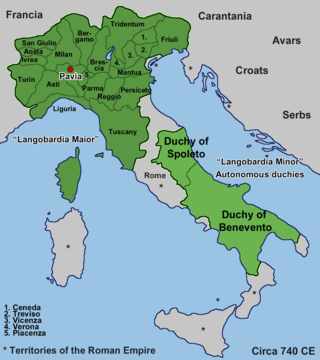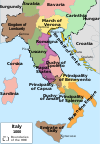
The Lombards or Longobards were a Germanic people who conquered most of the Italian Peninsula between 568 and 774.

Year 626 (DCXXVI) was a common year starting on Wednesday of the Julian calendar. The denomination 626 for this year has been used since the early medieval period, when the Anno Domini calendar era became the prevalent method in Europe for naming years.

Year 603 (DCIII) was a common year starting on Tuesday of the Julian calendar. The denomination 603 for this year has been used since the early medieval period, when the Anno Domini calendar era became the prevalent method in Europe for naming years.

Theodelinda also spelled Theudelinde, was a queen of the Lombards by marriage to two consecutive Lombard rulers, Autari and then Agilulf, and regent of Lombardia during the minority of her son Adaloald, and co-regent when he reached majority, from 616 to 626. For well over thirty years, she exercised influence across the Lombard realm, which comprised most of Italy between the Apennines and the Alps. Born a Frankish Catholic, she convinced her first spouse Autari to convert from pagan beliefs to Christianity.

King of Italy was the title given to the ruler of the Kingdom of Italy after the fall of the Western Roman Empire. The first to take the title was Odoacer, a barbarian military leader, in the late 5th century, followed by the Ostrogothic kings up to the mid-6th century. With the Frankish conquest of Italy in the 8th century, the Carolingians assumed the title, which was maintained by subsequent Holy Roman Emperors throughout the Middle Ages. The last Emperor to claim the title was Charles V in the 16th century. During this period, the holders of the title were crowned with the Iron Crown of Lombardy.

Authari was king of the Lombards from 584 to his death. He was considered as the first Lombard king to have adopted some level of Romanitas (Roman-ness) and introduced policies that led to drastic changes, particularly in the treatment of the Romans and greater tolerance for the Christian faith.

Rothari, of the house of Arodus, was king of the Lombards from 636 to 652; previously he had been duke of Brescia. He succeeded Arioald, who was an Arian like himself, and was one of the most energetic of Lombard kings. Fredegar relates that at the beginning of his reign he put to death many insubordinate nobles, and that in his efforts for peace he maintained very strict discipline.

Agilulf, called the Thuringian and nicknamed Ago, was a duke of Turin and king of the Lombards from 591 until his death.
Adaloald (602–628) was the Lombard king of Italy from 616 to 626.
Rodoald, was a Lombard king of Italy, who succeeded his father Rothari on the throne in 652. He was said to be lecherous and he was assassinated after a reign of just six months in 653 by the husband of one of his lovers. Paul the Deacon writes that Rodoald "had reigned five years and seven days, ", although historians note that this length of reign is suspect. Aripert, a rival claimant, was elected with the support of the Catholic Church, which opposed the Arian monarchy.

Aripert I was king of the Lombards (653–661) in Italy. He was the son of Gundoald, Duke of Asti, who had crossed the Alps from Bavaria with his sister Theodelinda. As a relative of the Bavarian ducal house, his was called the Bavarian Dynasty.

Perctarit was king of the Lombards from 661 to 662 the first time and later from 671 to 688.
The Bavarian dynasty was those kings of the Lombards who were descended from Garibald I, the Agilolfing duke of Bavaria. They came to rule the Lombards through Garibald's daughter Theodelinda, who married the Lombard king Authari in 588. The Bavarians were really a branch of the Agilolfings, and were themselves two branches: the branch descended in the female line through Garibald's eldest child and daughter, Theodelinda, and the branch descended from Garibald's eldest son Gundoald. Of the first branch, only Adaloald, Theodelinda's son by her second husband, whom she had chosen to be king, Agilulf, reigned, though her son-in-law Arioald also ruled. Through Gundoald, six kings reigned in succession, broken only by the usurper Grimuald, who married Gundoald's granddaughter:
Garibald was the young son of Grimoald I of Benevento, king of the Lombards, and Theodota, daughter of Aripert I. After his father's death in 671, he reigned briefly for three months until the numerous adherents of Perctarit, his uncle, who had been exiled by Grimoald nine years earlier, besought their candidate to return and elected him, deposing the young king. He was the last Arian king in Europe.

The Kingdom of the Lombards, also known as the Lombard Kingdom and later as the Kingdom of all Italy, was an early medieval state established by the Lombards, a Germanic people, on the Italian Peninsula in the latter part of the 6th century. The king was traditionally elected by the very highest-ranking aristocrats, the dukes, as several attempts to establish a hereditary dynasty failed. The kingdom was subdivided into a varying number of duchies, ruled by semi-autonomous dukes, which were in turn subdivided into gastaldates at the municipal level. The capital of the kingdom and the center of its political life was Pavia in the modern northern Italian region of Lombardy.
Secundus of Trent or Secundus of Non authored History of the Acts of the Langobards, up to 612.

The Duchy of Tridentum (Trent) was an autonomous Lombard duchy, established by Euin during the Lombard interregnum of 574–584 that followed the assassination of the Lombard leader Alboin. The stronghold of Euin's territory was the Roman city of Tridentum in the upper valley of the Adige, in the foothills of the Alps in northern Italy, where the duchy formed one of the marches of the Lombard Kingdom of Italy. There he shared power with the bishop, who was nominally subject to the Patriarch of Aquileia. In 574–75, Lombard raiding parties pillaged the valley of the Rhône, incurring retaliatory raids into the duchy by Austrasian Franks, who had seized control of the mountain passes leading into the kingdom of Burgundy. Euin was at the head of the army loyal to Authari that went into the territory of the duke of Friuli in Istria, c 589, and he was sent by Agilulf to make peace with the Franks his neighbors, in 591. After Euin's death c 595, Agilulf installed Gaidoald, who was a Catholic, rather than an Arian Christian. After some friction between king and duke, they were reconciled in 600. The separate Lombard duchy of Brescia was united with Tridentum in the person of Alagis, a fervent Arian and opponent of the Lombard king, Perctarit, who was killed in the battle of Cornate d'Adda (688).
Gaidoald was the second Lombard duke of Trent, succeeding Euin in 595.
Duke of Turin was the title of a line of dukes among the Lombards when they ruled Italy in the Early Middle Ages.











